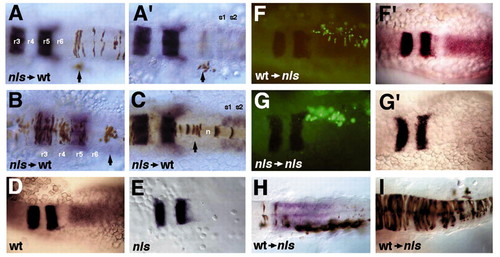Fig. 7
- ID
- ZDB-FIG-140326-2
- Publication
- Begemann et al., 2001 - The zebrafish neckless mutation reveals a requirement for raldh2 in mesodermal signals that pattern the hindbrain
- Other Figures
- All Figure Page
- Back to All Figure Page
|
Induction of neural hoxb4 expression in nls by transplanted wild-type somitic mesoderm. (A-C) In a wild-type host nls mutant donor cells (brown) contribute to hindbrain (A), spinal cord (A,B), paraxial mesoderm (A′, arrow) and notochord (C) at the head/trunk boundary. In situ hybridisation detects expression of krox20 in the hindbrain (r3, r5) and myoD in somites (s1,s2). (D,E) krox20 and hoxb4 expression in wild type and nls mutants. (F-G) Fluorescent images of donor cells and bright field images of hosts after stained for expression of krox20 and hoxb4; wildtype cells populating paraxial mesoderm of anterior somites and individual spinal cord neurones in a 15 hpf nls embryo (F); rescue of neural expression of hoxb4 by wild-type cells (F′); nls cells transplanted to the anterior somitic mesoderm of a nls host (G) are not able to induce neural hoxb4 expression (G′). (H) Another example of rescue of neural hoxb4 expression by transplanted wild-type cells (brown staining) in somites of a nls host. Note that both sides of the neural tube are rescued in F′ and H, although wild-type cells are unilaterally distributed. (I) Example of a 15 hpf nls embryo with a massive contribution of wild-type donor cells (brown staining) to the hindbrain and spinal cord. Hoxb4 expression is not induced in either donor or host-derived neural ectoderm. Dorsal views. |

